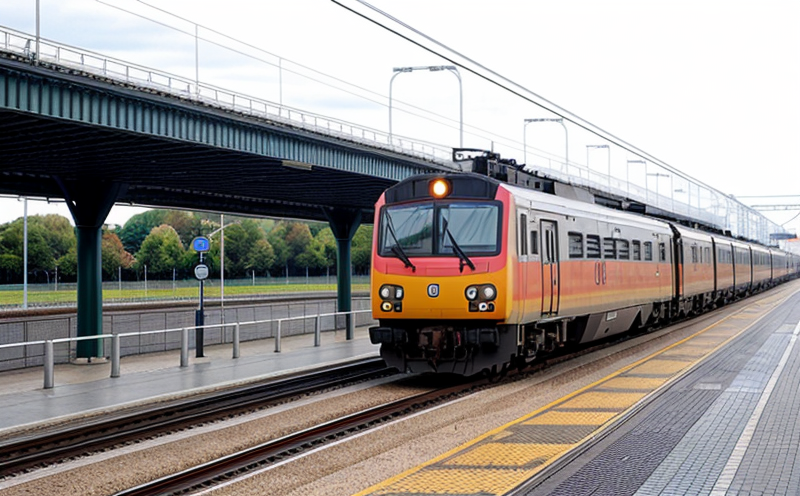EN 16272 Railway Infrastructure Noise Measurement
The European standard EN 16272 provides a comprehensive framework for measuring noise produced by railway infrastructure. This standard is crucial for ensuring compliance with environmental regulations and promoting sustainable transport systems. The primary focus of this service is to provide accurate, reliable, and compliant noise measurements according to the provisions laid out in EN 16272.
The scope of EN 16272 covers various aspects related to railway infrastructure noise measurement. This includes the identification and quantification of noise sources such as trains passing over ballast, wheel-rail interactions, and other structural components of the railway system. The standard specifies detailed procedures for conducting these measurements under controlled conditions.
The railway industry faces numerous challenges when it comes to managing noise pollution. These challenges range from understanding the complex interaction between the environment and infrastructure to ensuring that all stakeholders comply with relevant regulations. EN 16272 aims to address these issues by providing clear guidelines on how to measure noise effectively. Compliance with this standard ensures that railway operators meet environmental obligations while also improving public perception.
The measurement process involves several key steps, each designed to ensure accuracy and consistency in the results obtained. First, appropriate instrumentation must be selected based on the specific requirements of the project. This could include sound level meters capable of capturing both short-term peaks and long-term averages over extended periods. Proper placement of these devices is essential for obtaining representative data.
Once the instruments are set up correctly, field operations can begin. During this phase, careful observation and recording of environmental conditions such as wind speed, temperature, humidity, etc., are necessary to account for any external factors that might affect measurement results. It’s important to note that these variables should be monitored continuously throughout the entire testing period.
After collecting all required data points, it becomes possible to analyze them and derive meaningful insights about noise levels within specified limits defined by EN 16272. Reporting must follow strict formats outlined in the standard; this ensures uniformity across different projects and facilitates comparisons between results from various locations or time intervals.
By adhering strictly to the requirements set forth by EN 16272, organizations involved in railway infrastructure development can ensure their activities do not contribute excessively towards environmental degradation. Additionally, compliance helps protect them against potential legal action stemming from non-conformity with applicable legislation.
In conclusion, implementing EN 16272 represents an effective strategy for managing noise emissions associated with railway operations responsibly and sustainably. It enables accurate assessment of current levels while providing actionable recommendations aimed at reducing future impacts.
Benefits
- Compliance with European environmental regulations
- Promotion of sustainable transport systems
- Achievement of consistent and reliable noise measurement results
- Enhancement of public perception regarding railway operations
- Protection against potential legal actions
- Facilitation of comparisons between different projects or time intervals
- Development of actionable recommendations for reducing future impacts
Eurolab Advantages
At Eurolab, our expertise in acoustics, vibration, and noise testing ensures that we deliver high-quality services tailored specifically to meet the needs of clients operating within the railway sector. Our team comprises highly qualified professionals who have extensive experience working with standards like EN 16272.
We offer a range of additional benefits beyond mere compliance with regulatory requirements. By leveraging advanced technology and best practices, we can help optimize noise reduction strategies for our customers. For instance, through detailed analysis provided during the testing process, we identify areas where improvements could be made to minimize unwanted sound emissions without compromising functionality.
Furthermore, Eurolab prides itself on offering personalized attention to each project undertaken. This approach allows us to understand fully what our clients are trying to achieve and then develop customized solutions that best suit their goals. Whether you require assistance with planning, execution, or interpretation of results, we have the resources needed to support every step along the way.
Our commitment to excellence extends beyond just meeting current standards; it includes anticipating future trends in technology and legislation so that our clients remain ahead of competitors. By staying at the forefront of industry developments, Eurolab continues to provide value-added services which go above and beyond mere compliance.
Environmental and Sustainability Contributions
The practice of railway infrastructure noise measurement plays a vital role in promoting environmental sustainability by providing valuable information about the impact that railways have on surrounding areas. By measuring noise levels accurately, we can better understand how to mitigate adverse effects on human health and well-being.
One significant contribution made possible through EN 16272 is the ability to establish baseline measurements against which future improvements in noise management practices can be evaluated. This not only helps track progress but also demonstrates commitment to continuous improvement efforts aimed at reducing overall environmental footprint associated with rail transportation.
In addition, compliance with this standard encourages innovation within the sector by fostering a culture of proactive problem-solving focused on minimizing negative impacts while maximizing positive outcomes. As technology continues to evolve, so too do our methods for addressing challenges related to noise pollution in railways. Through ongoing research and development initiatives led by organizations like Eurolab, new solutions are constantly being explored and implemented.
Ultimately, the implementation of EN 16272 contributes significantly towards achieving broader goals associated with environmental sustainability within the railway industry. It serves as a foundation upon which further advancements can be built to create more efficient, cleaner, and greener forms of public transportation.





